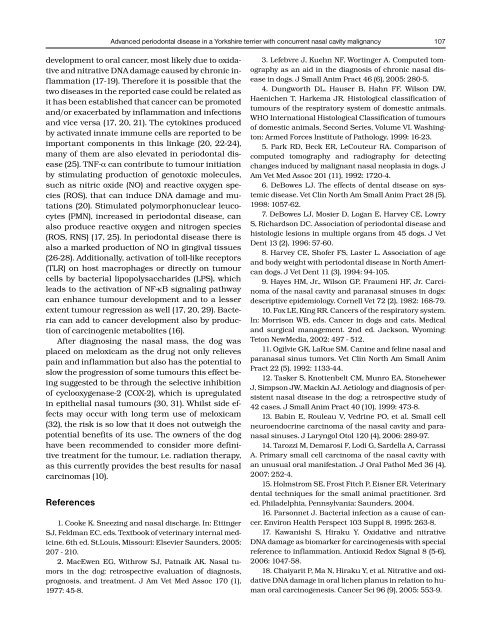the scientific journal of the veterinary faculty university - Slovenian ...
the scientific journal of the veterinary faculty university - Slovenian ...
the scientific journal of the veterinary faculty university - Slovenian ...
- No tags were found...
You also want an ePaper? Increase the reach of your titles
YUMPU automatically turns print PDFs into web optimized ePapers that Google loves.
Advanced periodontal disease in a Yorkshire terrier with concurrent nasal cavity malignancy107development to oral cancer, most likely due to oxidativeand nitrative DNA damage caused by chronic inflammation(17-19). Therefore it is possible that <strong>the</strong>two diseases in <strong>the</strong> reported case could be related asit has been established that cancer can be promotedand/or exacerbated by inflammation and infectionsand vice versa (17, 20, 21). The cytokines producedby activated innate immune cells are reported to beimportant components in this linkage (20, 22-24),many <strong>of</strong> <strong>the</strong>m are also elevated in periodontal disease(25). TNF-α can contribute to tumour initiationby stimulating production <strong>of</strong> genotoxic molecules,such as nitric oxide (NO) and reactive oxygen species(ROS), that can induce DNA damage and mutations(20). Stimulated polymorphonuclear leucocytes(PMN), increased in periodontal disease, canalso produce reactive oxygen and nitrogen species(ROS, RNS) (17, 25). In periodontal disease <strong>the</strong>re isalso a marked production <strong>of</strong> NO in gingival tissues(26-28). Additionally, activation <strong>of</strong> toll-like receptors(TLR) on host macrophages or directly on tumourcells by bacterial lipopolysaccharides (LPS), whichleads to <strong>the</strong> activation <strong>of</strong> NF-κB signaling pathwaycan enhance tumour development and to a lesserextent tumour regression as well (17, 20, 29). Bacteriacan add to cancer development also by production<strong>of</strong> carcinogenic metabolites (16).After diagnosing <strong>the</strong> nasal mass, <strong>the</strong> dog wasplaced on meloxicam as <strong>the</strong> drug not only relievespain and inflammation but also has <strong>the</strong> potential toslow <strong>the</strong> progression <strong>of</strong> some tumours this effect beingsuggested to be through <strong>the</strong> selective inhibition<strong>of</strong> cyclooxygenase-2 (COX-2), which is upregulatedin epi<strong>the</strong>lial nasal tumours (30, 31). Whilst side effectsmay occur with long term use <strong>of</strong> meloxicam(32), <strong>the</strong> risk is so low that it does not outweigh <strong>the</strong>potential benefits <strong>of</strong> its use. The owners <strong>of</strong> <strong>the</strong> doghave been recommended to consider more definitivetreatment for <strong>the</strong> tumour, i.e. radiation <strong>the</strong>rapy,as this currently provides <strong>the</strong> best results for nasalcarcinomas (10).References1. Cooke K. Sneezing and nasal discharge. In: EttingerSJ, Feldman EC, eds. Textbook <strong>of</strong> <strong>veterinary</strong> internal medicine.6th ed. St.Louis, Missouri: Elsevier Saunders, 2005:207 - 210.2. MacEwen EG, Withrow SJ, Patnaik AK. Nasal tumorsin <strong>the</strong> dog: retrospective evaluation <strong>of</strong> diagnosis,prognosis, and treatment. J Am Vet Med Assoc 170 (1),1977: 45-8.3. Lefebvre J, Kuehn NF, Wortinger A. Computed tomographyas an aid in <strong>the</strong> diagnosis <strong>of</strong> chronic nasal diseasein dogs. J Small Anim Pract 46 (6), 2005: 280-5.4. Dungworth DL, Hauser B, Hahn FF, Wilson DW,Haenichen T, Harkema JR. Histological classification <strong>of</strong>tumours <strong>of</strong> <strong>the</strong> respiratory system <strong>of</strong> domestic animals.WHO International Histological Classification <strong>of</strong> tumours<strong>of</strong> domestic animals, Second Series, Volume VI. Washington:Armed Forces Institute <strong>of</strong> Pathology, 1999: 16-23.5. Park RD, Beck ER, LeCouteur RA. Comparison <strong>of</strong>computed tomography and radiography for detectingchanges induced by malignant nasal neoplasia in dogs. JAm Vet Med Assoc 201 (11), 1992: 1720-4.6. DeBowes LJ. The effects <strong>of</strong> dental disease on systemicdisease. Vet Clin North Am Small Anim Pract 28 (5),1998: 1057-62.7. DeBowes LJ, Mosier D, Logan E, Harvey CE, LowryS, Richardson DC. Association <strong>of</strong> periodontal disease andhistologic lesions in multiple organs from 45 dogs. J VetDent 13 (2), 1996: 57-60.8. Harvey CE, Sh<strong>of</strong>er FS, Laster L. Association <strong>of</strong> ageand body weight with periodontal disease in North Americandogs. J Vet Dent 11 (3), 1994: 94-105.9. Hayes HM, Jr., Wilson GP, Fraumeni HF, Jr. Carcinoma<strong>of</strong> <strong>the</strong> nasal cavity and paranasal sinuses in dogs:descriptive epidemiology. Cornell Vet 72 (2), 1982: 168-79.10. Fox LE, King RR. Cancers <strong>of</strong> <strong>the</strong> respiratory system.In: Morrison WB, eds. Cancer in dogs and cats. Medicaland surgical management. 2nd ed. Jackson, Wyoming:Teton NewMedia, 2002: 497 - 512.11. Ogilvie GK, LaRue SM. Canine and feline nasal andparanasal sinus tumors. Vet Clin North Am Small AnimPract 22 (5), 1992: 1133-44.12. Tasker S, Knottenbelt CM, Munro EA, StonehewerJ, Simpson JW, Mackin AJ. Aetiology and diagnosis <strong>of</strong> persistentnasal disease in <strong>the</strong> dog: a retrospective study <strong>of</strong>42 cases. J Small Anim Pract 40 (10), 1999: 473-8.13. Babin E, Rouleau V, Vedrine PO, et al. Small cellneuroendocrine carcinoma <strong>of</strong> <strong>the</strong> nasal cavity and paranasalsinuses. J Laryngol Otol 120 (4), 2006: 289-97.14. Tarozzi M, Demarosi F, Lodi G, Sardella A, CarrassiA. Primary small cell carcinoma <strong>of</strong> <strong>the</strong> nasal cavity withan unusual oral manifestation. J Oral Pathol Med 36 (4),2007: 252-4.15. Holmstrom SE, Frost Fitch P, Eisner ER. Veterinarydental techniques for <strong>the</strong> small animal practitioner. 3rded. Philadelphia, Pennsylvania: Saunders, 2004.16. Parsonnet J. Bacterial infection as a cause <strong>of</strong> cancer.Environ Health Perspect 103 Suppl 8, 1995: 263-8.17. Kawanishi S, Hiraku Y. Oxidative and nitrativeDNA damage as biomarker for carcinogenesis with specialreference to inflammation. Antioxid Redox Signal 8 (5-6),2006: 1047-58.18. Chaiyarit P, Ma N, Hiraku Y, et al. Nitrative and oxidativeDNA damage in oral lichen planus in relation to humanoral carcinogenesis. Cancer Sci 96 (9), 2005: 553-9.
















